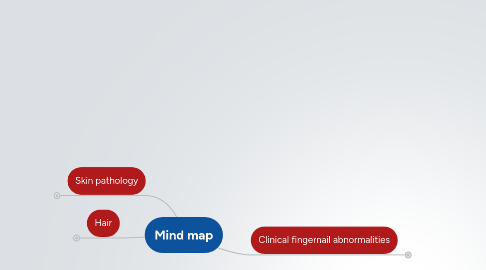
1. Skin pathology
1.1. 1. Psoriasis
1.1.1. Description
1.1.1.1. 1. A common, chronic immune-mediated skin disease which may also affect the joints 2. Affects approx. 2% of US population. 3. All ages can be affected; bimodal peak age at onset (adolescence & 60 yrs). 4. Sometimes associated with arthritis, myopathy, enteropathy, spondylitic joint disease.
1.1.2. Cause
1.1.2.1. Autoimmune. Strong HLA-C association
1.1.3. Clinical finding
1.1.3.1. 1. Well-demarcated, pink to salmon-colored plaques covered by characteristic silver-white scale. 2. Frequently affects elbows, knees, scalp, lumbrosacral area, intergluteal clefts, & glans penis 3. Koebner phenomenon (Lesions can be induced by local trauma). 4. Auspitz sign (Pinpoint bleeding when scales are scraped off).
1.1.3.2. 5. Nail pitting
1.1.4. Treatment
1.1.4.1. Self limiting. Steroids as needed.
1.2. 2. Tumors of cellular migrants to the skin
1.2.1. Overview
1.2.1.1. Proliferations of cells that develop in other locations in the body & migrate to the skin.
1.2.2. Types
1.2.2.1. Mycosis fungoides
1.2.2.1.1. Description
1.2.2.1.2. Clinical findings
1.2.2.1.3. Stages
1.2.2.2. Sezary syndrome (Cutaneous T-cell lymphoma)
1.2.2.2.1. Description
1.2.2.2.2. Clinical findings
1.2.2.2.3. Histology
1.2.2.3. Mastocytosis (group of disorders)
1.2.2.3.1. Overview
1.2.2.3.2. Examples
1.3. 3. Seborrheic Dermatitis
1.3.1. Description
1.3.1.1. 1. A common inflammatory skin condition that causes flaky, white to yellowish scales to form on oily areas such as the scalp or inside the ear. It can occur with or without reddened skin. Cradle cap is the term used when seborrheic dermatitis affects the scalp of infants. 2. Affects 3-5% of population.
1.3.2. Clinical finding
1.3.2.1. 1. Involves areas w/high density of sebaceous glands (scalp, forehead, external auditory canal). 2. Causes dandruff (cradle cap in infants) 3. Macules & papules on an erythematous-yellow, greasy base with extensive scaling & crusting.
1.3.2.2. Top picture: "cradle cap"
1.3.3. Cause
1.3.3.1. Most often the fungus Malassezia furfur
1.3.4. Treatment
1.3.4.1. Selenium sulfite (OTC shampoo called Selson Blue)
1.4. 4. Lichen planus
1.4.1. Description
1.4.1.1. 1. Recurrent, pruritic, inflammatory disorder that affects the skin & oral mucosa. 2. Slight female predominance. 3. 30-60 yrs of age. 4. Associated with Hepatitis C, and may be found with autoimmune diseases.
1.4.2. Clinical finding
1.4.2.1. 1. The 6 P's
1.4.2.1.1. 6P's: 1. Pruritic 2. Purple 3. Polygonal 4. Planar 5. Papules 6. Plaques
1.4.2.2. 2. Oral lesions
1.4.2.2.1. 1. Seen in about 70% of cases. 2. Present as white reticulated lesions.
1.4.3. Cause
1.4.3.1. Unknown
1.4.4. Histology
1.4.4.1. 1. Acanthosis (Epidermal thickening) 2. Saw-toothed rete ridge (zigzag contour of dermoepidermal junction). 3. Lymphocytic infiltrate along dermoepidermal junction
2. Hair
2.1. More content coming soon!
3. Clinical fingernail abnormalities
3.1. Name, description, cause
3.1.1. Name
3.1.1.1. Longitudinal lines
3.1.2. Description
3.1.2.1. Vertical hyperpigmented bands that extend across entire nail plate, but should not extend to cuticle or other skin.
3.1.3. Cause
3.1.3.1. 1. Melanoma. 2. Occasionally, normal, benign finding in African population.
3.2. Name, description, cause
3.2.1. Name
3.2.1.1. Beau's line
3.2.2. Description
3.2.2.1. Transvers depression of the nail plate that grows out
3.2.3. Cause
3.2.3.1. Anything that can affect the rate of nail growth from severe systemic illness, meds
3.3. Name, description, cause
3.3.1. Name
3.3.1.1. Onycholysis
3.3.2. Description
3.3.2.1. Separation of the nail plate from bed
3.3.3. Cause
3.3.3.1. Multiple causes from psoriasis, to fungal infection.
3.4. Name, description, cause
3.4.1. Name
3.4.1.1. Leukonychia
3.4.2. Description
3.4.2.1. Abnormal keratinization of nail matrix leading to white/depigmentation of nail plate
3.4.3. Cause
3.4.3.1. Physiologic, common finding. Idiopathic and benign
3.5. Name, description, cause
3.5.1. Name
3.5.1.1. Median nail dystrophy
3.5.2. Description
3.5.2.1. Abnormal nail plate line along length of nail
3.5.3. Cause
3.5.3.1. Caused by trauma
3.6. Name, description, cause
3.6.1. Name
3.6.1.1. Schamroth's sign (clubbing)
3.6.2. Description
3.6.2.1. This may fit both nail plate and nail bed abnormalities because the plate is abnormal but in varying degrees of clubbing the surround soft tissue is affected. Considered a results of vascular abnormalities in nail
3.6.3. Cause
3.6.3.1. Indication of systemic disease. Causes cardiovascular, pulmonary, GI disease, Hyperthyroidism, HIV.
3.7. Name, description, cause
3.7.1. Name
3.7.1.1. Pitting
3.7.2. Description
3.7.2.1. Many small divets on most if not all nails
3.7.3. Cause
3.7.3.1. Psoriasis
3.8. Name, description, cause
3.8.1. Name
3.8.1.1. Koilonychia
3.8.2. Description
3.8.2.1. Spoon shape abnormality of nail. iron def. The lateral edges of the nail extend upward
3.8.3. Cause
3.8.3.1. physiologic in childrenor diabetes mellitus in adults.
3.9. Name, description, cause
3.9.1. Name
3.9.1.1. Splinter hemmorhage
3.9.2. Description
3.9.2.1. Longitudinal pigmented abnormality in nail bed.
3.9.3. Cause
3.9.3.1. May be from trauma, psoriasis and most notably endocarditis
3.10. Name, description, cause
3.10.1. Name
3.10.1.1. Paronychia
3.10.2. Description
3.10.2.1. Inflammed, white or red skin around lesion. Likely only on a single or adjacent fingers
3.10.3. Cause
3.10.3.1. Infection (inflammatory response).
